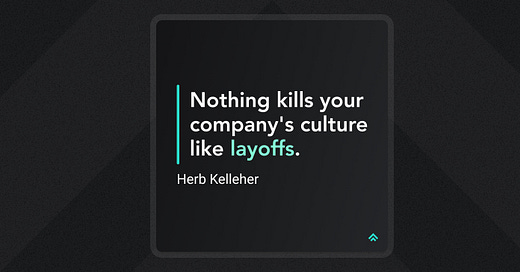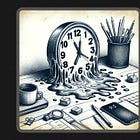Hello! I’m Pat and Better by Design is my newsletter devoted to helping you get a strategic edge in the next era of creative technology. If you’re new here, join our tribe of creative tech hybrids as we uncover new insights each week.
Hello friends,
I got laid off… again.
But don’t shed any tears for me, I’m fine; this time I was prepared.
Coincidentally, I was planning to give my two weeks’ notice only a few days after the layoff took place. So, from a financial perspective, getting laid off was actually a better outcome for me. But, emotionally, it’s still a weird way to end the chapter. Once again, I didn’t get to go out on my own terms and the tenuous relationship between tech companies and employees is front and center in my mind.
Sadly, this is the natural state of that relationship (at least in America); one moment a job is in demand and lucrative, and the next it doesn’t exist. Like it or not, this is how the American employment machine is designed to operate. From a business perspective, it’s an effective system. But from a personal one, it’s brutal if you aren’t prepared for the reality of how it operates.
I’ve been laid off three times over the course of my decade in business, and today I want to share my experience with you so that you might be a little more prepared than I was for these inevitable moments.
Layoff #1 – American Express, 2016
My first layoff experience came in 2016 when American Express downsized its Enterprise Growth division.
In my estimation, this was a run-of-the-mill corporate downsizing. The company had lost one of its major partnerships which led to a financial hit to its bottom line. I worked in an R&D division that was more susceptible to downsizing since the company ran it at a loss to incubate new growth opportunities. With that in mind, it wasn’t too surprising that Amex chose to scale the division back when faced with economic headwinds.
I loved this job and the big, talented design team I got to be a part of, so I was bummed when it came to an end. However, I at least had the solidarity of “going down with the ship” in person along with 75% of the team.
Amex gave us multiple months of notice prior to the official layoff date, the option to interview for positions in other parts of the business, and multiple months of severance if we moved on.
While I chose to leave the company to pursue other opportunities this was a pretty understandable and well-handled layoff, in my opinion.
Layoff #2 – Signal Sciences, 2020
My next layoff shocked me and reframed the way I think about my relationship with tech companies.
In the spring of 2020, after pouring my creative energy into the cybersecurity startup Signal Sciences, I got laid off again. Although this came during widespread COVID layoffs, it still took me by surprise.
I thought I was safe.
I could do my job remotely and had specific knowledge about the product that would be impossible to replace. I felt “essential” to the business as I had designed the experience for some of the platform’s core features.
And yet, those factors didn’t matter.
I got notified of my layoff on a Monday morning, the company shut down my laptop that afternoon, and that was it.
18 months of my creative energy vanished in a matter of hours and two-thirds of my equity expired due to lack of vesting.
While in the moment it seemed as if the driver of the layoff was the same macroeconomic uncertainty faced by everyone, in retrospect it appears that the company was preparing for acquisition and needed to cut headcount to facilitate the deal. A couple of months later, the company was acquired by Fastly, and ended up needing to rehire my role (turns out it was important after all…). I went back for about 8 months but quickly realized that the new situation wasn’t for me and that my bond with the company had been broken beyond repair.
I don’t begrudge Signal Sciences for laying me off. I was just naive and didn’t understand the true terms of the agreement I had made when I joined the company as an employee. I let myself get too emotionally invested in something that wasn’t mine and paid the price.
While I can be upset about my outcome, if I’m being honest, I would have made the same choice the founders did if I had been the one looking down the barrel of a life-changing acquisition. So now, I just keep the memory to remind myself to maintain a healthier emotional distance from the products I create for others.
Layoff #3 – JupiterOne, 2023
Recently, I was laid off by JupiterOne, the tech startup I joined in July 2021.
The company let go of its entire product design team (four people) in the process of cutting headcount by ~20-25%.
To give you a sense of where I started at JupiterOne: When I joined the company we didn’t even have a team Figma account. I designed what we needed from the ground up and at one point supported a team of over 40 engineers on my own. I exceeded expectations each year, received merit raises, and got promoted, which I mention only to illustrate that good performance does not protect you in situations like these.
My manager had a Zoom call to inform the team that we were all laid off, the company shut down my laptop the next morning, and just like that two more years of work were gone. This time I didn’t even get a meeting with an HR person, only emails dictating the terms of the separation.
Between my prior layoff experiences and the fact that I was already planning to move on, this sequence of events didn’t hit me as hard as before, but I think it reinforces the fragility of the relationship between tech employees and employers. Tech companies talk a good game about their devotion to their people but at the end of the day, they’re profit-seeking enterprises that exist to return value to their shareholders. If cutting headcount will help a company achieve that objective, it won’t hesitate.
Lessons
Full-time “at-will” employment isn’t a bad gig, but you need to be honest about the terms of the agreement. No matter your tenure, your position, or your perceived indispensability, a company operates on logic as cold as steel. When its calculations dictate that letting you go benefits the bottom line, rest assured, it won't hesitate. And when that moment arrives? It'll do the bare minimum required by law, acting in its own best interest. Understand that these are the terms of the agreement and do business accordingly.
Network well in advance of when you need it. Many people wait to network until they’re actively in need of a new job. This is a mistake. Be diligent about making connections while you’re still happy in your current role. These are the best moments to connect with people because you don’t need anything from anyone. You can just meet people where they are and make new friends. These are the kinds of relationships that are easiest to call upon in times of need: the ones that were established well before you ever needed help.
Build things that you own. The most brutal part of my layoffs was waking up to the fact that I didn’t own any of the creative projects I had given thousands of hours of my life to create. This feeling of loss was one of the main drivers behind starting Better by Design. I knew that I wanted to own as much of my creative output as possible and creating this newsletter was one small way for me to begin down that path. I own the output from the thousands of hours I’ve put into it so far, and I’ll own the output from the many hours yet to come. Employers and their projects will come and go, but now I have something they can’t take from me and that’s incredibly motivating as I venture on to whatever’s next.
Final thoughts
I didn’t anticipate writing about layoffs this week, but I had to get it off my chest.
Now, onwards to my original plan: dedicate more time to making Better by Design the marquee Substack for creative technology people.
Have a layoff experience you’re open to sharing? Tell us about it in the comments.
I imagine a lot of folks will appreciate the openness.
Until next time,
Pat 💚
If you got a little value from this post, consider subscribing, sharing, or following me on Twitter. If you got a lot of value, I’d appreciate it if you bought me a coffee 😎☕️.








I'm in the same boat. If the company is not selling or not selling enough, they need to cut cost. We all get that. The question is the selection process. Keep looking and don't give up.
Much respect, Pat. Excited to see what you do next.